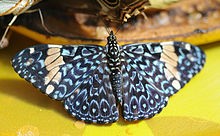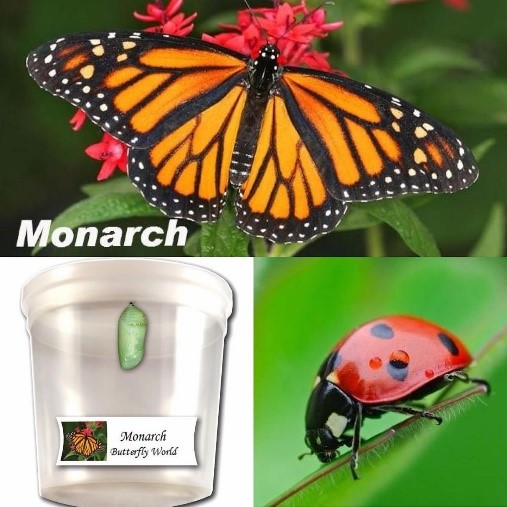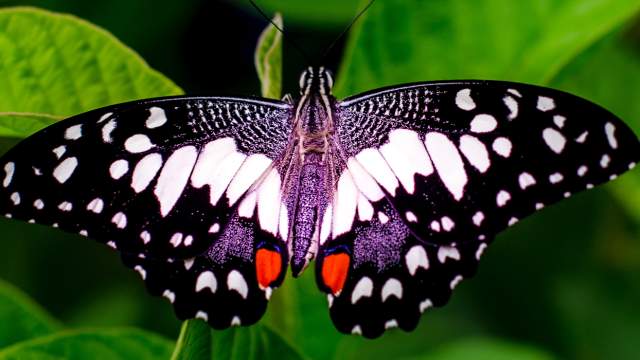@visitlauderdale
Your browser is not supported for this experience.
We recommend using Chrome, Firefox, Edge, or Safari.
Lesson 3: Butterflies
In Coconut Creek, we have our own little butterfly oasis called Butterfly World. Have you ever been? After you enter in through Tradewinds Park and start to walk to the ticketing office you will hear lovely music that will transport you into a magical land of butterflies.
Besides being beautiful (mostly) why are butterflies important to our ecosystem?
Butterflies play an important role in pollinating flowers, particularly flowers that have a strong scent, are red or yellow in color and produce a large amount of nectar. Nectar is an important component of a butterfly’s diet. Butterflies have been around for at least 50 million years and probably first evolved some 150 million years ago.
An abundance of butterflies is often an indication that an ecosystem is thriving. This is because butterflies are an important component of a food chain, as predators and prey. Adult butterflies and caterpillars are an important source of food for other animals such as bats and birds. Along with nectar, butterflies eat a variety of plants. Some species also provide a natural form of pest control. For example, the harvester butterfly eats aphids (Vocabulary: small sap-sucking insects) while it is in its caterpillar form.
There are more than 18,500 different species of butterflies.
At Butterfly World, you will find between 50-80 different species of butterflies throughout the year. They have thousands of butterflies in their aviaries year-round and sometimes up to 20,000 at once!
Have you ever heard of a “cracker butterfly?” 
The “cracker” family of butterflies can make a ‘crackling’ noise with their wings (males only). Butterfly World houses three species of crackers, the Starry Night Cracker, the Grey Cracker and the Red Cracker.
Cracker butterflies are commonly found throughout South America to Arizona and about nine species can be found in Costa Rica. They spend most of the day perching on trees, boulders, and other such surfaces against which they are camouflaged. Since cracker butterflies have good camouflage, they are not poisonous and do not have a chemical defense, except for the starry night cracker.
Butterflies found at Butterfly World
Florida State Butterfly: Zebra Longwing
In 1996, the State of Florida designated the Zebra Longwing as the official state butterfly. The zebra longwing is a neotropical  butterfly that occurs in extreme southern portions of the United States southward through Mexico, Central America and the West Indies to South America. Adults occasionally wander northward. It is locally common throughout peninsular Florida. It is a regular sight in many butterfly gardens and suburban yards and parks. The zebra longwing produces multiple generations each year. Adults may be found in all months of the year throughout much of central and southern portions of Florida. Adults have slow, relaxed flight. Adult zebra longwing butterflies feed on both flower nectar and pollen. The additional nutrients from the pollen enable individuals to survive for several months, far exceeding the normal two to four-week adult life span of most other butterflies. Adult individuals often form small communal roosts at night.
butterfly that occurs in extreme southern portions of the United States southward through Mexico, Central America and the West Indies to South America. Adults occasionally wander northward. It is locally common throughout peninsular Florida. It is a regular sight in many butterfly gardens and suburban yards and parks. The zebra longwing produces multiple generations each year. Adults may be found in all months of the year throughout much of central and southern portions of Florida. Adults have slow, relaxed flight. Adult zebra longwing butterflies feed on both flower nectar and pollen. The additional nutrients from the pollen enable individuals to survive for several months, far exceeding the normal two to four-week adult life span of most other butterflies. Adult individuals often form small communal roosts at night.
Endangered Butterfly: Swallowtail 
The Schaus swallowtail is one of Florida’s endangered species, this butterfly has the special ability to stop midair and fly backwards to avoid their predators. Butterfly World has aided conservation efforts throughout the state. The Schaus swallowtail has black-brown wings with yellow markings and a broad rusty patch underneath the hind wing. One of the reasons it is unique is because it can stop suddenly in mid-air and fly backwards to avoid its predators — birds, lizards, and spiders. Conservation of the species is particularly important because random events could cause its extinction. Adult individuals have a lifespan of only one month.
The Famous Monarch:

The monarch butterfly is native to the Americas, but in the nineteenth century or before, it spread across the world, and is now found in Australia, New Zealand, other parts of Oceania, and the Iberian Peninsula.
Monarchs are known for their long migration; but did you know that Florida has a permanent population that never goes to Mexico?
This permanent population breeds year-round and enjoys the sunny and mild weather of south Florida. Have you seen Monarchs outside your home or near school before?
Fun Facts!
- Butterflies navigate using a time-compensated sun compass. They can see polarized light and therefore orient even in cloudy conditions.
- Butterflies have TWO antenna, FOUR wings and SIX legs.
-
Butterflies have wings covered in tiny scales (yes, just like the fish ones!) that give them their color, ability to fly and act as tiny solar panels to take in solar energy.
-
Butterflies don’t have a mouth, instead they have a double straw-like tongue called a “proboscis” from which they drink their food.
-
Butterflies are on an “all liquid” diet when they’re adults; they can only sip nectar, rotting fruit juice, and water.
-
Caterpillars are very picky with their meals; they will only eat from their host plants, but adult butterflies eat from a variety of sources.
Career Corner!
Curator: Kind of sounds like a creator, right? Well this type of a creator is one that creates life in a museum, zoo or something similar like Butterfly World! Maybe it also sounds like “cure.” The word curator comes from the Latin word “cura” meaning to take care of. So, in terms of this career corner, it would mean to take care of a museum, zoo, etc.
The actual definition of a curator is a “keeper or custodian of a museum or other collection.”
What do curators typically do?

Create collections of exhibits for a museum
Build up collections and specialist areas (like the bug area at Butterfly World!)
Purchase or loan exhibits to / from their museum
Organize exhibits / Arrange artifacts
Keep track of the museum’s items
Office Manager: When you think of a cool place like Butterfly World, perhaps an “office manager” does not really come first to mind; however, most businesses do in fact need an office manager. What tasks do you think an office manager handle?
Imagine all the fun places that you could work at as an office manager, like Butterfly World!
An office manager typically will do these types of tasks in their job:
- Organize meetings and arrange appointments
- Handle correspondence, complaints and queries
- Book transport and accommodation
- Order office supplies and furniture
- Prepare letters, presentations and reports
- Supervise and monitor the work of secretarial, clerical and administrative staff
- Managing office budgets
- Work with staff, suppliers and clients
- Implement and maintain procedures/office administrative systems
- Delegate tasks to junior employees
- Organize induction programs for new employees
- Ensure that health and safety policies are up to date
- Use a range of software packages
- Handle staff recruitment and appraisals
- Attend meetings with senior management
Quiz & Activity Time!
Click here to take the quiz and activity.


